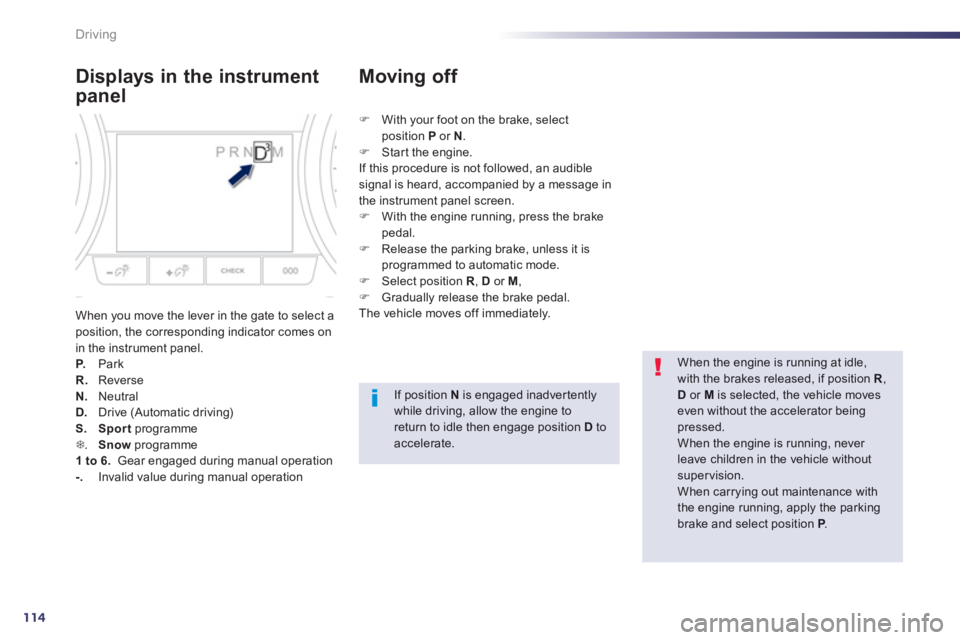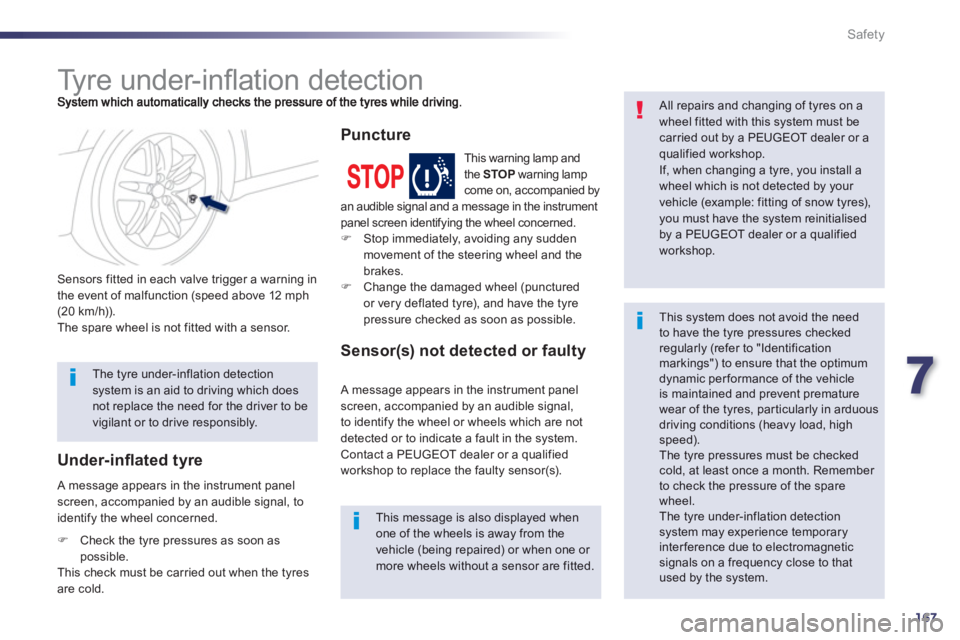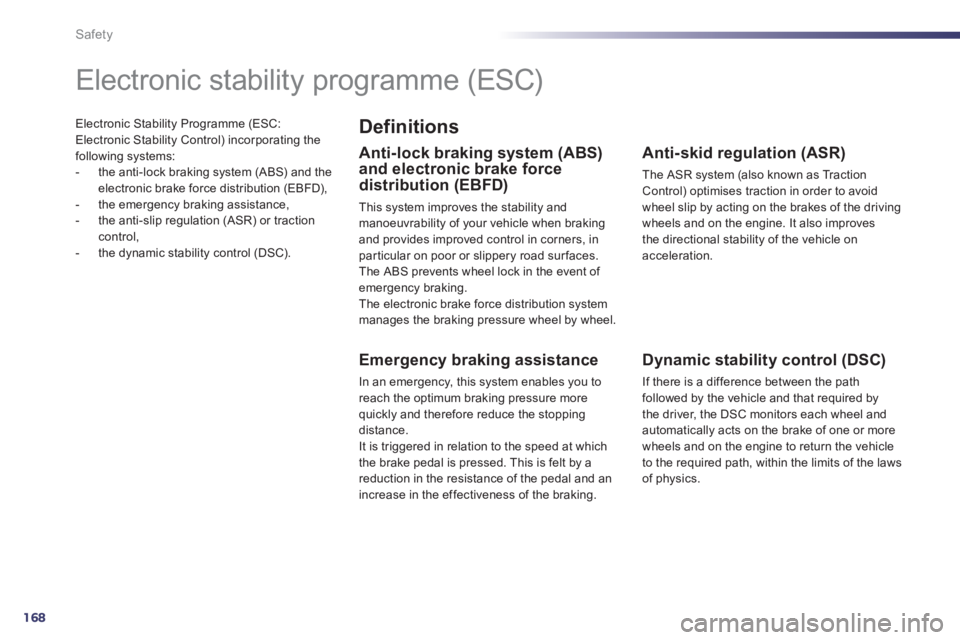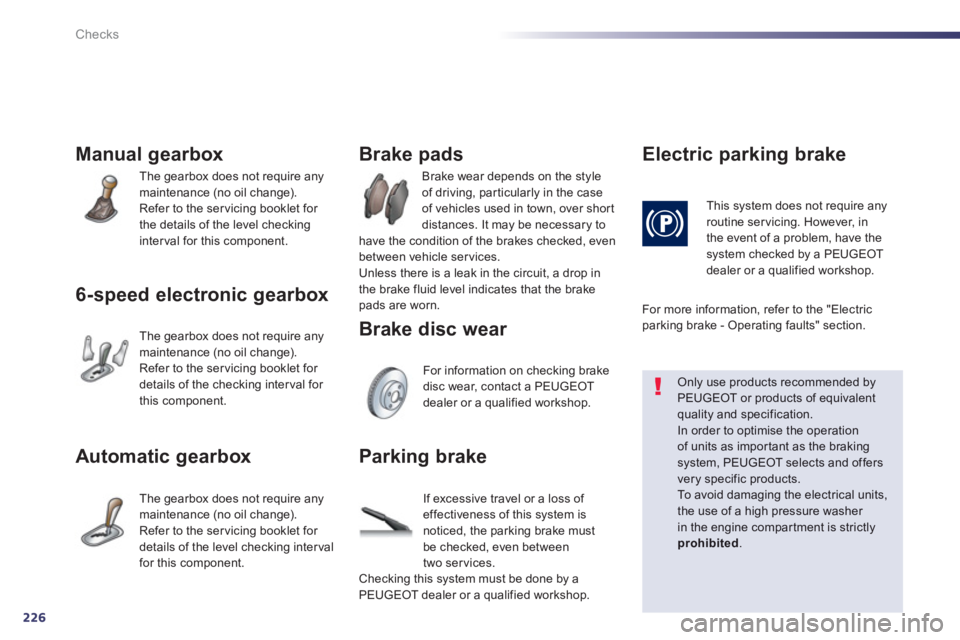2013 Peugeot 508 brakes
[x] Cancel search: brakesPage 116 of 340

114
Driving
Displays in the instrument
panel
When you move the lever in the gate to select aposition, the corresponding indicator comes on in the instrument panel. P. Park R.ReverseN.
Neutral D.
Drive (Automatic driving)
S. Sport programmeT. Snow
programme 1 to 6.
Gear engaged during manual operation -.Invalid value during manual operation
F
With your foot on the brake, select position Por N.F
Star t the engine.
If this procedure is not followed, an audible
si
gnal is heard, accompanied by a message in
the instrument panel screen.
F With the engine running, press the brake
pedal.F Release the parking brake, unless it is
programmed to automatic mode. F Select position R
, D
or M
, F
Gradually release the brake pedal.
The vehicle moves off immediately.
Moving off
When the engine is running at idle, with the brakes released, if position R,D
or Mis selected, the vehicle moves even without the accelerator being pressed.
When the engine is running, never leave children in the vehicle without supervision. When carrying out maintenance with the engine running, apply the parkingbrake and select position P.P
If position Nis engaged inadvertently while driving, allow the engine to return to idle then engage position Dto accelerate.
Page 169 of 340

7
167
Safety
Ty r e u n d e r - i nfl ation detection
Sensors fitted in each valve trigger a warning in
the event of malfunction (speed above 12 mph (20 km/h)).
The spare wheel is not fitted with a sensor.
All repairs and changing of tyres on awheel fitted with this system must becarried out by a PEUGEOT dealer or a qualified workshop.
If, when changing a tyre, you install awheel which is not detected by your vehicle (example: fitting of snow tyres), you must have the system reinitialised
by a PEUGEOT dealer or a qualifiedworkshop.
This message is also displayed whenone of the wheels is away from thevehicle (being repaired) or when one or more wheels without a sensor are fitted.
The tyre under-inflation detectionsystem is an aid to driving which doesnot replace the need for the driver to bevigilant or to drive responsibly.
This system does not avoid the needto have the tyre pressures checkedregularly (refer to "Identification markings") to ensure that the optimumdynamic performance of the vehicleis maintained and prevent premature wear of the tyres, particularly in arduousdriving conditions (heavy load, highspeed). The tyre pressures must be checked cold, at least once a month. Remember to check the pressure of the spare wheel.
The tyre under-inflation detection system may experience temporary interference due to electromagnetic signals on a frequency close to that used by the system.
A message appears in the instrument panelscreen, accompanied by an audible signal, to
identify the wheel concerned.
Under-infl ated tyre
This warning lamp and
the STOPwarning lamp come on, accompanied by an audible signal and a message in the instrument panel screen identifying the wheel concerned. FStop immediately, avoiding any sudden
movement of the steering wheel and thebrakes.
FChange the damaged wheel (punctured
or very deflated tyre), and have the tyre
pressure checked as soon as possible.
Puncture
A message appears in the instrument panel
screen, accompanied by an audible signal,
to identify the wheel or wheels which are not
detected or to indicate a fault in the system.Contact a PEUGEOT dealer or a qualifiedworkshop to replace the faulty sensor(s).
Sensor(s) not detected or faulty
F
Check the tyre pressures as soon aspossible.
This check must be carried out when the tyres
are cold.
Page 170 of 340

168
Safety
Electronic Stability Programme (ESC: Electronic Stability Control) incorporating the
following systems:
- the anti-lock braking system (ABS) and the
electronic brake force distribution (EBFD),
- the emergency braking assistance,
- the anti-slip regulation (ASR) or traction
control,
- the dynamic stability control (DSC).
Electronic stability programme (ESC)
Definitions
Anti-lock braking system (ABS)
and electronic brake force
distribution
(EBFD)
This system improves the stability and
manoeuvrability of your vehicle when braking
and provides improved control in corners, in
par ticular on poor or slippery road surfaces.
The ABS prevents wheel lock in the event of emergency braking.
The electronic brake force distribution system
manages the braking pressure wheel by wheel.
Emergency braking assistance
In an emergency, this system enables you to reach the optimum braking pressure more quickly and therefore reduce the stoppingdistance.
It is triggered in relation to the speed at which
the brake pedal is pressed. This is
felt by areduction in the resistance of the pedal and an
increase in the effectiveness of the braking.
Anti-skid regulation (ASR)
The ASR system (also known as Traction Control) optimises traction in order to avoid
wheel slip by acting on the brakes of the drivingwheels and on the engine. It also improves
the directional stability of the vehicle onacceleration.
Dynamic stability control (DSC)
If there is a difference between the pathfollowed by the vehicle and that required bythe driver, the DSC monitors each wheel and
automatically acts on the brake of one or more
wheels and on the engine to return the vehicle
to the re
quired path, within the limits of the laws
of physics.
Page 214 of 340

212
Practical information
Driving advice
Distribution of loads
FDistribute the load in the trailer so that theheaviest items are as close as possible to
the axle and the nose weight approaches
the maximum permitted without
excee
ding it.
Air density decreases with altitude, thus reducingengine performance. Above 1 000 metres, the maximum towed load must be reduced by 10 %
for every 1 000 metres of altitude.
Side wind
FTake into account the increased sensitivity
to side wind.
Cooling
To w i ng a trailer on a slope increases the
temperature of the coolant.
As the fan is electricall
y controlled, its cooling capacity is not dependent on the engine speed.
F
To lower the engine speed, reduce your speed.
The maximum towed load on a long incline
depends on the
gradient and the ambient
temperature.
In all cases, keep a check on the coolant
temperature.
FIf the warning lamp and the
STOP warning lamp come on, stop the vehicle and switch off
the engine as soon as possible.
Braking
To w i ng a trailer increases the braking distance.
To avoid overheating of the brakes on a longmountain type of descent, the use of engine braking is recommended.
Tyres
F
Check the tyre pressures of the towingvehicle and of the trailer, obser ving the recommended pressures.
Lighting
F
Check the electrical lighting and signalling on the trailer.
The rear parking sensors will be deactivated automatically if a genuine PEUGEOT towbar is used.
R
efer to the "Technical Data" section for details
of the weights and towed loads which apply to your vehicle.
Page 228 of 340

226
Checks
Manual gearbox
The gearbox does not require any
maintenance (no oil change).
Refer to the servicing booklet for
the details of the level checkinginterval for this component.
6-speed electronic gearbox
The gearbox does not require any
maintenance (no oil change).
Refer to the servicing booklet for
details of the checking inter val for
this component.
Automatic gearbox
The gearbox does not require any
maintenance (no oil change).
Refer to the ser vicing booklet for
details of the level checkin
g interval
for this component. Brake wear depends on the st
yle
of driving, par ticularly in the case
of vehicles used in town, over shor t
distances. It ma
y be necessary to
have the condition of the brakes checked, even between vehicle services.
Unless there is a leak in the circuit, a drop in
the brake fluid level indicates that the brake pads are worn.
Brake pads
For information on checking brake
disc wear, contact a PEUGEOT
dealer or a qualified workshop.
Brake disc wear
Electric parkin
g brake
This system does not require any routine servicing. However, in
the event of a problem, have the
system checked by a PEUGEOT
dealer or a qualified workshop.
Only use products recommended by PEUGEOT or products of equivalentquality and specification. In order to optimise the operationof units as impor tant as the braking system, PEUGEOT selects and offersvery specific products.
To a v o i d d a m aging the electrical units,the use of a high pressure washer in the engine compar tment is strictly
prohibited.
Parking brake
If excessive travel or a loss of effectiveness of this system isnoticed, the parking brake must
be checked, even between
tw
o services.
Checking this system must be done by aPEUGEOT dealer or a qualified workshop.
For more information
, refer to the "Electric parking brake - Operating faults" section.
Page 329 of 340

.
327 Alphabetical index
Accessories ..................................................214Accessory socket, 12 volt ...............................77Adjusting headlamps .................................... 144Adjusting head restraints..........................67,70Adjusting seat belt height..............................172Adjusting the steering wheel...........................76Airbags............................................................32Airbags, curtain .....................................176,177Airbags, front.........................................174,177Airbags, lateral......................................176,177Air conditioning.........................................20, 89Air conditioning, digital........................87,90, 98Air conditioning, manual...........................87, 88Air conditioning, quad-zone...............93, 96, 98Air filter..........................................................r225Air flow............................................................20Air vents ..........................................................86Alarm ...............................................................53Anti-theft........................................................102Armrest............................................................77Armrest, rear...................................................r78Assistance call......................................166,240Audible warning............................................166Audio streaming (Bluetooth).........284,310,312Audio system (radio).....................................297Automatic illumination
of headlamps .......................................137, 141Automatic operation of hazard
warning lamps.............................................165Automatic rain sensitive
windscreen wipers..............................147,149Auxiliary socket.............................................309
Backup switching off.....................................f102Battery..................................................204, 225Battery, charging ...........................................204Battery, remote control.............................50-52Blind................................................................61Bluetooth (hands-free)..........................267, 311Bluetooth (telephone)....................................267Boot...........................................................57-59Boot (opening).................................................46Brake discs ....................................................226Brake lamps ..........................................196,197Brake pads ....................................................226Brakes...........................................................226
Capacity, fuel tank..........................................64CD.................................................................304CD MP3 ................................................305, 306Central locking................................................47Changing a bulb ....................191, 196,197, 199Changing a fuse............................................200Changing a wheel.................................184,185Changing a wiper blade........................150,208Changing the date.....................................41,42Changing the remote control battery........50, 51Changing the time.....................................41,42Checking levels .....................................222-224Checking the engine oil level ..........................37Checking tyre pressures (using the kit) ........178Checks ..................................219-221, 225, 226Children.........................................157, 161,162Child seats ...........................153,154,156,159Child seats, conventional......................156, 157Closing the boot..............................................57Closing the doors............................................47
Date (setting).............................................41,42Daytime running lamps.........139, 191,193, 195Deactivating ESP ..........................................170Deactivating the passenger airbag ...............174
Deadlocking ....................................................48Defrosting........................................................98Diesel..............................................................25Diesel additive level......................................224Diesel engine pre-heat warning lamp.............25Dimensions ...................................................236Dipped beam ..................................136,191-193Dipstick ....................................................37, 222Directional lighting ................................ 145, 146Direction indicators........140,165, 191,195-197Driving positions (memorising).......................69Dynamic emergency braking........................103Dynamic stability control (DSC)........27, 30, 170
AB
C
D
Connectors, audio ...........................79, 307, 309Coolant level ...........................................33,223Coolant temperature indicator........................r33Courtesy lamps.............................................151Cruise control........................................127,130Cup holder.......................................................r77
Eco-driving.....................................................20Eco-driving (advice)........................................20Economical driving .........................................20Economy mode .............................................207
E